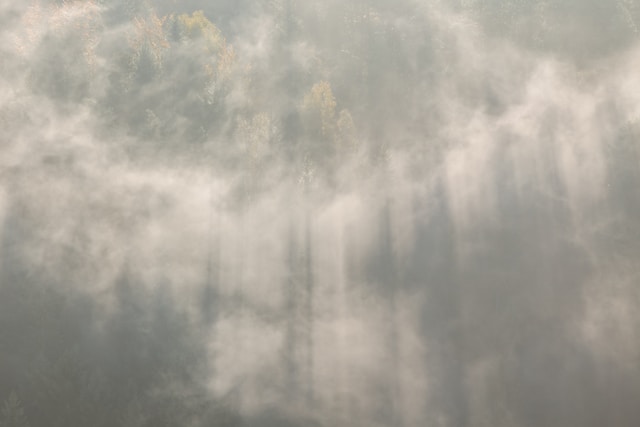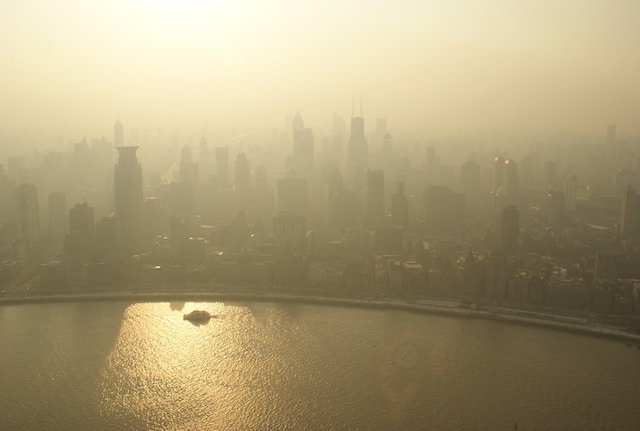Haze is a type of air pollution caused by particles in the atmosphere that scatter sunlight and reduce visibility. Fog, on the other hand, is formed when moisture in the air condenses into tiny water droplets close to the ground.
What is Haze?
(Photo by Paul Earle on Unsplash )

Haze is a weather phenomenon characterized by the presence of tiny particles and pollutants in the air. These particles can be natural, such as dust or pollen, or man-made, like smoke from factories or vehicles. Haze is not limited to urban areas but occurs worldwide due to various sources.
One type of haze that people might be familiar with is smog, which consists of a combination of smoke and fog. However, there are other types of haze too: photochemical smog forms when sunlight reacts with chemicals released into the air by cars and factories while winter haze results from temperature inversions trapping pollution close to ground level.
Haze can have significant health implications for those who are exposed to it regularly since it irritates respiratory systems leading to breathing problems. It also affects visibility levels causing difficulty while driving on roads resulting in accidents.
Despite its harmful effects on humans and the environment alike, combating haze remains an ongoing challenge globally.
What is fog?
(Photo by Artem Sapegin on Unsplash )

Fog is a weather phenomenon that occurs when there is a high concentration of water droplets suspended in the air. It forms close to the ground and reduces visibility, making it difficult for drivers and pedestrians alike to navigate safely.
There are several different types of fog, including radiation fog, advection fog, upslope fog, and evaporation or steam fog. Radiation fog happens on clear nights when heat from the ground radiates into the atmosphere causing cooling and condensation of moisture. Advection fog is created when warm moist air moves over colder land or water surfaces resulting in condensation.
Upslope Fog occurs as a result of moist air moving up an elevated plain where it cools and creates clouds which lead to precipitation while evaporative or steam fogs form due to cold dry air passing over warmer waters resulting in cloud formation.
Understanding what causes each type of fog can help us better prepare for hazardous driving conditions caused by reduced visibility due to this meteorological event.
Haze Vs. Fog – Key differences
Haze and fog are two terms that often get used interchangeably, but they actually refer to different atmospheric conditions.
Fog is a type of cloud that forms close to the ground when moisture in the air condenses and becomes visible. Fog can occur in various types – radiation, advection, upslope, steam or freezing – depending on specific weather conditions.
Haze is an atmospheric phenomenon characterized by a low concentration of fine particles scattered throughout the air. These tiny particles come from sources like pollution, dust storms or wildfires. Hazy conditions tend to affect visibility more than anything else.
The main difference between haze and fog lies in their formation mechanism: fog arises when water droplets condense into tiny liquid droplets while haze occurs due to suspended solid or liquid particles scattering light.
While both terms refer to reduced visibility caused by moisture and particulate matter in the atmosphere, it’s important not to confuse them as they have different implications for health and safety concerns.
The different types of haze
Haze is a form of atmospheric pollution that can be found in different parts of the world. It occurs when tiny particles, such as dust, smoke or pollen, are suspended in the air and reduce visibility. There are several types of haze depending on their source and composition.
One type of haze is photochemical smog, which forms when pollutants from vehicle exhausts and industrial processes react with sunlight. This type of haze is commonly found in urban areas with high traffic levels and can be harmful to human health.
Another type is wildfire smoke haze which results from combustion fires burning out natural vegetation or manmade substances like plastics releasing fine particulate matter into the atmosphere causing low visibility.
Dust storm or desert sandstorm happen when strong winds pick up dust particles from arid regions and transport them across long distances leading to reduced visibility over large areas.
There’s also agricultural crop burning which produces thick layers of smoke that blanket entire regions during specific times because farmers burn dry leaves before planting crops again.
Understanding the different types of haze helps us identify their sources and develop effective strategies to minimize their impact on both public health & safety while reducing environmental degradation caused by these events.
The different types of fog
Fog is a type of cloud that forms near the ground and reduces visibility. There are different types of fog depending on how they form. Advection fog, for example, occurs when warm moist air passes over a cool surface and cools down to its dew point temperature. This type of fog is common in coastal areas where sea breezes blow moisture-laden air over relatively colder land surfaces.
Radiation fog is another type that forms overnight when the ground cools rapidly under clear skies, causing the surrounding air to cool as well until it reaches saturation or the dew point temperature. It usually clears up during mid-morning once the sun heats up the earth’s surface.
Upslope fog occurs when humid air moves up along sloping terrain such as mountainsides and cools enough to reach its dew point temperature; this causes clouds or fogs to form.
Steam fog, also known as “sea smoke,” can be seen in cold winter mornings when cold dry Arctic air flows over warmer water bodies like lakes and oceans creating steam-like formations above them.
Freezing fog occurs at temperatures below freezing (0°C/32°F) where tiny liquid droplets freeze instantly upon contact with surfaces forming ice crystals that coat everything around it from trees to power lines making it hazardous for transportation services.
What is mist?
Mist is a phenomenon that many people often confuse with fog. While they might look similar, there are some differences between them. Mist occurs when water droplets are suspended in the air and reduce visibility to less than one kilometer. It’s usually not as thick as fog and doesn’t last as long.
Mist typically forms on calm, clear nights when the temperature drops and causes moisture in the air to condense into tiny droplets. The presence of mist can make everything appear hazy or blurry, which can create stunning visual effects during sunrise or sunset.
The thickness and opacity of mist depend on several factors such as altitude, humidity levels, temperature, wind speed, etc. Warm mist is formed by hot steam interacting with cooler air while cold mist happens due to colder temperatures causing humid conditions.
One of the benefits of mist is its ability to provide natural moisture for plants in areas where rainfall is scarce. In fact, many greenhouses use artificial misting systems to keep their plants hydrated without overwatering them.
While it might seem like a small difference compared to fog or haze – understanding what makes up each weather event helps us better comprehend our environment’s complexities!
How is fog and haze formed?
Fog and haze are both atmospheric phenomena that can cause visibility problems. While they may appear similar, their formation processes differ.
Fog is formed when the temperature of the air drops below its dew point, causing water vapor to condense into tiny water droplets or ice crystals. This often occurs in areas where cool air moves over warmer bodies of water or land surfaces, which causes moisture in the air to condense.
Haze, on the other hand, forms when dust, smoke particles or other pollutants suspend themselves in the atmosphere and reduce visibility. It can also form from natural sources such as pollen and sea salt spray.
In urban areas with high levels of pollution and smog, haze is a common occurrence. In rural areas near large agricultural regions during certain times of year produce crop residue burning that leads to increased levels of haze.
Both fog and haze can be dangerous for drivers as they decrease visibility on roads and highways. Understanding how these atmospheric conditions are formed is crucial for taking appropriate safety measures while traveling in affected areas.
Featured Image By – Alex Gindin on Unsplash








